Smartwatch battery failure occurs when excess heat triggers an uncontrollable cycle of chemical reactions. Your device’s lithium compounds become unstable at high temperatures, causing electrolyte breakdown and gas buildup that can lead to thermal runaway. Short circuits, physical activity, environmental heat, and prolonged charging all worsen this condition. When the watch can’t dissipate heat fast enough, battery swelling, rupture, or even burns may result. Discover how to protect your device and prevent dangerous overheating scenarios.
Understanding the Chemical Reactions Behind Battery Overheating
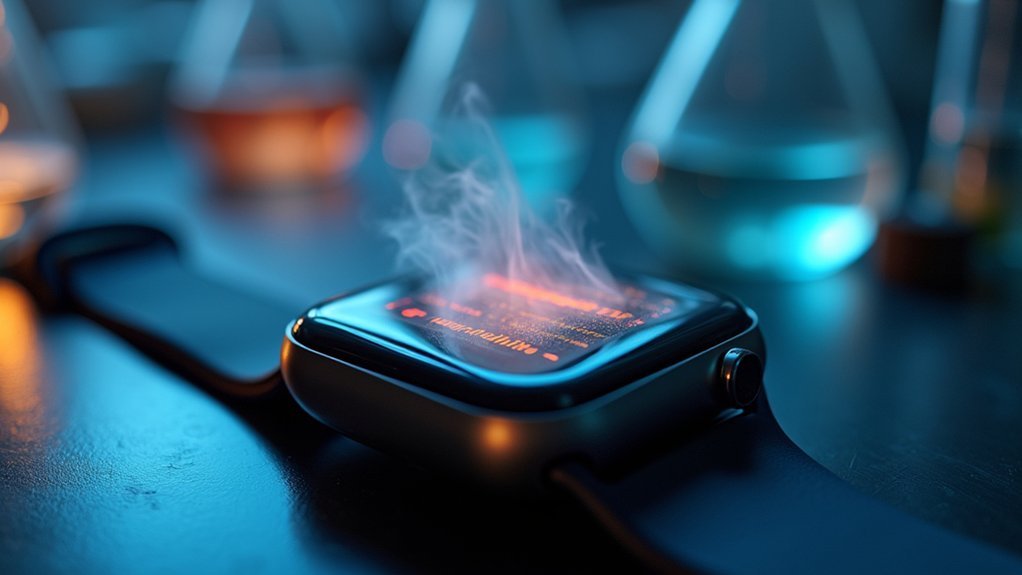
When a smartwatch starts feeling warm against your wrist, complex chemical processes are already underway inside its battery. The lithium compounds in your device’s battery are highly reactive, and they’re surrounded by a liquid or gel electrolyte that facilitates ion movement.
As temperatures rise, this electrolyte becomes unstable and begins to decompose, generating additional heat and gases. This triggers a dangerous feedback loop called thermal runaway—each exothermic reaction produces heat that accelerates further reactions.
The breakdown of cathode materials and electrolyte oxidation intensify this process. Meanwhile, structural integrity weakens as battery components expand and degrade. Gas buildup increases internal pressure, potentially causing the battery to swell or rupture. Thermal simulation software can accurately predict how these reactions will affect surrounding tissue and the potential for burns.
These reactions often begin at tiny defect sites before spreading throughout the battery.
How Short Circuits Lead to Thermal Runaway in Smartwatches
Short circuits represent one of the most dangerous failure modes in smartwatch batteries, often triggering a cascade of destructive reactions.
Battery short circuits unleash destructive chain reactions within smartwatches, creating one of the most hazardous failure scenarios possible.
When your device’s separator between battery cells fails due to damage or defects, direct electrical contact creates a bypass that generates intense localized heat.
This heat accelerates chemical reactions within the lithium-ion cells, creating a dangerous feedback loop. As temperatures rise beyond the battery’s dissipation capacity, thermal runaway begins. The electrolyte breaks down, releasing flammable gases that cause swelling and potential rupture. Regular battery integrity checks can significantly reduce the risk of thermal runaway incidents.
What makes smartwatches particularly vulnerable is their compact design with limited heat dissipation.
If you drop your watch or expose it to extreme temperatures, you’re increasing short circuit risk. The thin metal casing can quickly transfer this heat directly to your skin.
The Role of Watch Materials in Heat Dissipation
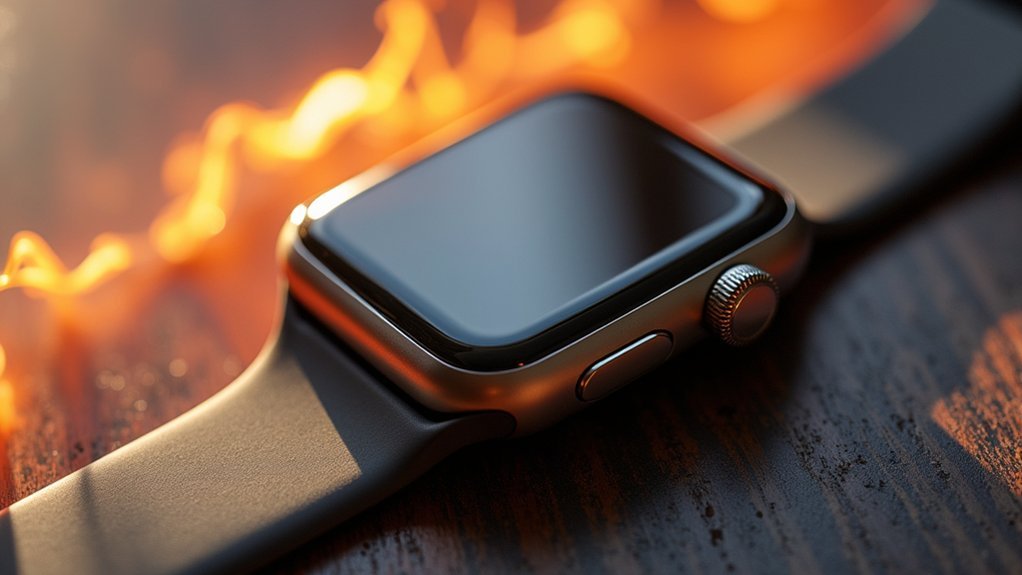
The materials used in smartwatch construction play a fundamental role in managing the heat generated during battery failures. Metals like stainless steel conduct heat away from batteries and your skin more efficiently than plastics, which can trap heat and create dangerous hot spots during thermal events.
When you choose a smartwatch, consider that material selection directly impacts your safety:
- Metal casings spread heat more evenly across the device, reducing burn risk during prolonged heating scenarios.
- Advanced fabrics like ultra-high molecular weight polyethylene provide cooling benefits while maintaining flexibility.
- Materials with high solar reflectivity and emissivity properties can keep your watch cooler during outdoor activities.
The thickness and layering of materials also affect heat transfer, with proper design preventing heat concentration against your skin. Smart watches should be designed to maintain a temperature rise within 1K during standby to prevent discomfort from localized heating.
Real-World Incidents: Notable Smartwatch Overheating Cases
Despite manufacturers’ safety claims, smartwatch battery failures have led to numerous documented incidents with serious consequences for users. Fitbit’s recall of 1.7 million Ionic smartwatches followed 78 burn cases, with some users suffering second and third-degree burns. The CPSC received at least 115 overheating reports by March 2022, highlighting the widespread nature of the problem.
| Brand | Incident Type | Scale | Outcome | Year |
|---|---|---|---|---|
| Fitbit | Battery overheating | 1.7M units recalled | $12.25M civil penalty | 2022 |
| Samsung | Galaxy Watch 5 Pro | Multiple complaints | Performance fixes | 2023 |
| Fitbit | Burn injuries | 115 US, 59 global | Second-degree burns | 2022 |
| Multiple | Software issues | Industry-wide | Firmware updates | Ongoing |
| Various | Environmental causes | User-reported | Usage guidelines | Ongoing |
The severity of these incidents demonstrates the real dangers of lithium-ion battery failures in wearable technology and the critical need for both regulatory oversight and consumer vigilance.
Exercise and Environmental Factors Affecting Battery Temperature
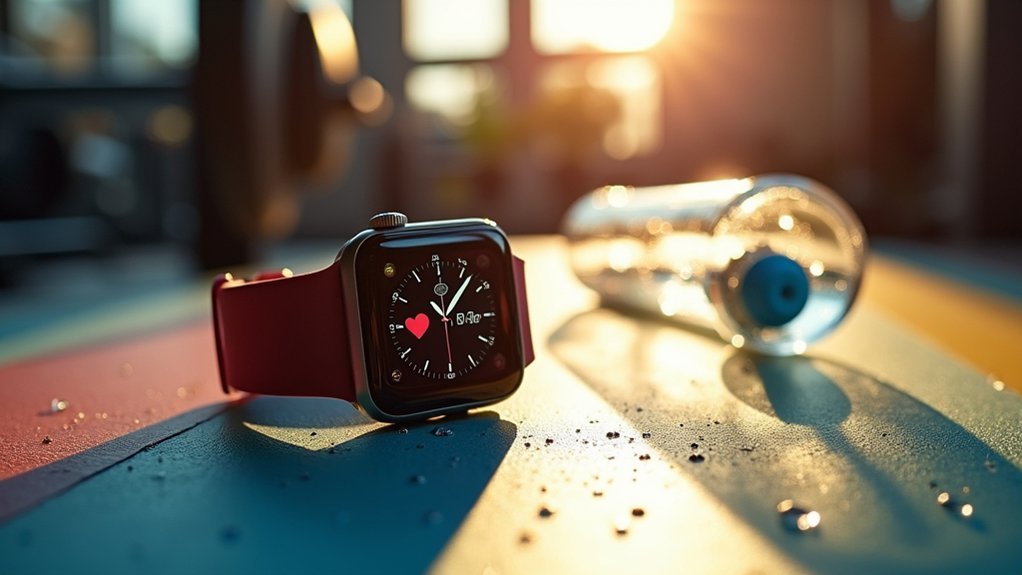
Beyond the headline-grabbing incidents of battery failures, everyday factors greatly influence smartwatch battery temperature and performance. Your physical activity level creates a complex thermal relationship with your device – vigorous exercise initially increases skin temperature under your watch but then triggers cooling mechanisms like sweating and increased blood flow, which can help dissipate battery heat. The various health monitoring sensors in smartwatches require continuous power when active, contributing to battery heat generation during extended exercise sessions.
- Environmental temperature extremes greatly impact battery life, with high heat accelerating chemical degradation and cold temperatures reducing efficiency.
- Skin temperature fluctuations during workouts affect thermal conductivity between your wrist and the device, potentially increasing thermal stress on battery components.
- Heat strain monitoring features in modern smartwatches can help identify conditions where both your body and the device might be experiencing concerning temperature elevations.
Thermal Management Systems in Modern Smartwatches
Modern smartwatches employ sophisticated thermal management systems to prevent battery damage from excessive heat.
You’ll find both passive cooling designs that use thermal pads and conductive materials like graphite films to spread heat away from critical components without consuming power.
Advanced devices may incorporate miniature heat pipes or phase change materials that absorb excess heat during intensive tasks, maintaining ideal temperature ranges for longer battery life.
Engineers carefully consider working period and duty cycle when designing these thermal solutions, as they directly influence temperature rise and overall power consumption.
Heat Dissipation Technologies
While batteries remain the literal heartbeat of smartwatches, their longevity depends greatly on effective thermal management systems.
Today’s devices employ various solutions to combat heat buildup that can degrade battery performance over time.
Thermoelectric cooling modules provide dual benefits—they convert your body heat into supplemental power while simultaneously cooling internal components.
Meanwhile, active thermal management systems use micro-fans and sensors to detect and address hotspots before they damage your battery. Some advanced systems even incorporate core temperature estimation algorithms similar to those developed by Lincoln Laboratory at MIT.
- Graphite sheets and thermal interface materials (TIMs) spread heat evenly throughout the device
- EMI shielding serves double duty by reducing electromagnetic noise and creating thermal conduction pathways
- Flexible heat-spreading layers beneath displays maintain uniform temperatures without adding bulk
These technologies work together to prevent the localized heating that accelerates battery degradation in your smartwatch.
Passive Cooling Designs
Passive cooling systems represent the silent guardians of your smartwatch’s battery health.
These systems use advanced materials like ceramic bases, graphite, and copper films to spread heat effectively without requiring power.
Your watch’s vapor chambers and strategically placed PCMs (Phase Change Materials) manage sudden temperature spikes during intensive tasks.
The watch belt itself serves as an additional heat exchange surface, contributing to overall thermal regulation.
Modern smartwatches incorporate colored passive radiative coolers that can reduce temperatures by nearly 4°C below ambient air temperature.
These cooling technologies utilize metal-insulator-metal structures with specialized layers of SiO2 and Si3N4.
When designed properly through thermal simulations and ergonomic considerations, these systems can improve thermal conductivity by up to 242% while maintaining user comfort.
However, traditional metallic heat sinks can create a Faraday cage effect, obstructing wireless communication that is essential for smartwatch functionality.
The Science of Battery Degradation Under Heat Stress
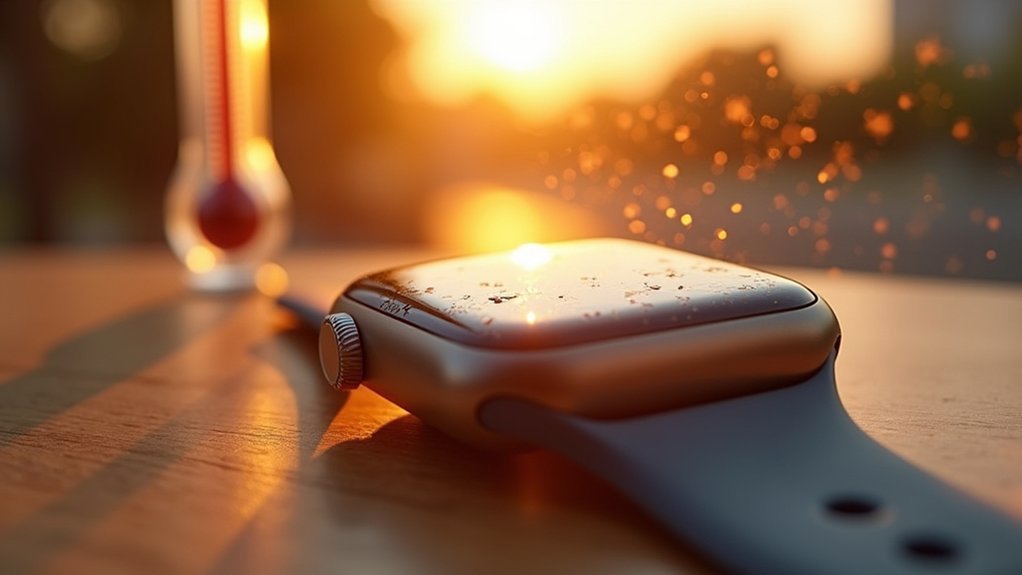
When your smartwatch gets hot, chemical reactions in the battery accelerate dramatically, potentially triggering a dangerous thermal runaway cycle where heat creates more heat.
You’ll find the electrolyte and electrode materials breaking down faster at elevated temperatures, leading to increased internal pressure, gas formation, and eventual battery failure.
The composition of your watch case—whether metal or plastic—affects how this heat dissipates, with metal conducting heat away from components more quickly but potentially transferring it to your skin. This is why proper temperature monitoring is essential, as demonstrated by the Fitbit Ionic recall that occurred after 174 reported overheating incidents.
Chemical Reactions Accelerate
The fundamental chemistry of lithium-ion batteries makes them particularly vulnerable to heat stress. When your smartwatch experiences elevated temperatures, the chemical reactions inside the battery markedly accelerate. This increases ion movement between electrodes, forcing the battery to work harder and degrade faster.
While this acceleration temporarily boosts energy output, it creates a dangerous trade-off that considerably shortens your device’s lifespan. The irreversible nature of this damage means your battery won’t recover once it’s been compromised by heat. Calendar aging continues regardless of use, but is significantly worsened by persistent exposure to high temperatures.
- Reaction rates can double with every 10°C increase in temperature
- Heat stress creates permanent capacity loss that can’t be restored
- Even brief exposure to high temperatures can trigger accelerated degradation
This is why manufacturers design thermal management systems, attempting to keep batteries within their ideal operating temperature range.
Thermal Runaway Dangers
Thermal runaway represents the most catastrophic failure mode your smartwatch battery can experience. This dangerous chain reaction occurs when internal short circuits—often caused by manufacturing defects or physical damage—trigger uncontrollable heat buildup.
As temperatures rise, the battery’s electrolyte decomposes into flammable gases that can spontaneously ignite. This poses serious burn risks, especially concerning since smartwatches sit directly against your skin. The device’s material composition considerably influences injury severity during such failures. The presence of visible smoke indicates immediate battery failure and the onset of thermal runaway in your smartwatch.
What makes thermal runaway particularly treacherous is its cascading nature. Once initiated, adjacent cells can overheat and fail sequentially, potentially leading to fire or even explosion.
Environmental factors worsen this risk—high ambient temperatures reduce heat dissipation capabilities, while aging batteries and improper charging practices increase susceptibility to this dangerous phenomenon.
Material Impact Matters
Heat’s relentless assault on smartwatch batteries triggers complex electrochemical changes that greatly impact their lifespan.
When your device overheats, it accelerates the breakdown of the critical solid electrolyte interphase (SEI) layer, compromising the battery’s stability and increasing self-discharge rates.
The materials in your smartwatch battery respond differently to thermal stress:
- Lithium-ion batteries degrade faster, typically retaining only 80% capacity after 300-500 cycles when exposed to heat.
- LiPo batteries show better resistance, losing about 15% capacity after 400-600 cycles due to their flexible structure.
- Fast or wireless charging generates additional heat that compounds material deterioration, especially if you leave your watch at 100% charge.
Parking your smartwatch in a hot car can rapidly accelerate chemical degradation, potentially cutting months off your battery’s effective lifespan.
Regulatory Standards for Wearable Device Heat Safety

Wearable device manufacturers must navigate complex regulatory frameworks to confirm their products meet stringent heat safety standards worldwide. UL IEC 62368-1 serves as a cornerstone international standard that establishes temperature limits to prevent burns and skin discomfort.
Your smartwatch undergoes extensive thermal testing that simulates real-world conditions, verifying it won’t overheat during everyday use. These tests aren’t just formalities—they’re vital safeguards that protect you from potential hazards.
When you purchase a certified device, you’re benefiting from rigorous lab testing protocols that verify temperature regulation across various operational stresses. Many premium wearables include real-time monitoring capabilities that detect dangerous temperature increases before battery damage occurs.
As regulations evolve, manufacturers must continuously update their certification to maintain compliance. This ongoing process helps confirm your wearable remains safe throughout its lifecycle, preventing heat-induced battery failures.
Practical Tips to Prevent Smartwatch Overheating
While your smartwatch comes equipped with thermal protection systems, implementing practical preventive measures can greatly extend battery life and enhance overall device longevity.
Managing your device’s energy consumption is critical—disable GPS, heart rate tracking, and Bluetooth when not actively using them, and consider activating power-saving modes during extended wear periods. Closing unused apps simultaneously can significantly reduce processor load and prevent overheating issues.
Strategic power management is essential—turn off unused features and embrace power-saving modes during long sessions.
- Charge smartly by using only manufacturer-recommended chargers, avoiding prolonged charging after reaching 100%, and never using your device intensively while it’s connected to power.
- Keep software updated to benefit from thermal management improvements and clear storage space regularly to reduce processor strain.
- Remove protective cases during charging or intense activities and avoid exposing your watch to direct sunlight or hot environments.
The Future of Heat-Resistant Battery Technologies
Your next-generation smartwatch will likely use graphene cooling layers that efficiently dissipate heat away from battery cells during intensive operations.
Solid-state batteries represent another major advancement, eliminating liquid electrolytes that can leak and cause thermal runaway in conventional lithium-ion cells.
These technologies will work together to create wearables that run cooler and safer while extending battery lifespan considerably. Advanced Battery Management Systems will provide real-time monitoring of temperature conditions, proactively adjusting power consumption to prevent overheating before it occurs.
Graphene Cooling Solutions
Emerging as a groundbreaking solution for smartwatch thermal management, graphene cooling technology represents the next frontier in battery protection.
With thermal conductivity surpassing traditional materials like copper, graphene efficiently dissipates heat from your smartwatch’s components, preventing battery degradation and extending device lifespan.
Companies like Huawei have already integrated graphene cooling systems into their devices, while Apple is rumored to be exploring similar solutions for future products. Samsung’s curved watch demonstrates how transparent screens enhanced by graphene can contribute to flexible and durable displays while managing heat effectively.
You’ll benefit from:
- Faster charging capabilities without dangerous temperature spikes
- Longer battery life through consistent temperature regulation
- Enhanced device performance during processor-intensive tasks
This revolutionary material enables manufacturers to develop thinner, more powerful smartwatches that remain cool even under demanding conditions.
As the technology scales up, you’ll soon see graphene cooling become standard in premium wearable devices.
Solid-State Battery Advantages
Solid-state battery technology stands at the forefront of addressing the heat-related failures that plague today’s smartwatches. Unlike conventional lithium-ion batteries, solid-state versions replace flammable liquid electrolytes with stable solid materials, dramatically reducing overheating and thermal runaway risks.
You’ll notice significant advantages with this advancement: higher energy density packed into smaller sizes, allowing for slimmer watch designs without sacrificing runtime.
These batteries operate reliably across wider temperature ranges—crucial when your device is constantly exposed to body heat. The non-flammable electrolytes virtually eliminate fire hazards while preventing dendrite formation that causes short circuits. Recent testing demonstrates impressive resilience with a self-discharge rate of only 6% per month even at extreme temperatures of 85°C.
Plus, you’ll spend less time charging, as they can reach 80% capacity in just 10-15 minutes. With a lifespan of approximately 5,000 cycles (versus 1,000 for typical lithium-ion), they’re both more durable and environmentally friendly.
How Manufacturers Are Addressing Thermal Design Challenges
Because smartwatches must operate reliably in a confined space against your skin, manufacturers face unique thermal design challenges that directly impact battery longevity.
They’re implementing sophisticated solutions to manage heat without compromising your comfort or device performance. Efficient thermal management is crucial as excessive heat can significantly degrade battery performance and lead to premature failure of components.
- Advanced materials deployment: Graphene films and graphite composites spread heat laterally across the device while phase change materials absorb thermal energy during high-processing activities.
- Intelligent power management: Dynamic throttling algorithms and selective component shutdowns protect batteries when temperatures rise, prioritizing critical functions.
- Comprehensive testing protocols: Environmental chambers simulate extreme conditions while 3D thermal mapping identifies potential hotspots that could damage battery cells or create uncomfortable skin contact.
These strategies help maintain temperatures below the critical 45°C threshold for skin contact while extending battery lifespan.
Frequently Asked Questions
Can Smartwatch Batteries Explode While Worn on the Wrist?
Yes, your smartwatch battery can explode while worn. Thermal runaway from overcharging, manufacturing defects, or physical damage can cause explosions, resulting in severe burns directly on your wrist.
Does Wireless Charging Increase Overheating Compared to Wired Charging?
Yes, your smartwatch will heat up more with wireless charging than wired charging. Wireless methods create additional heat through electromagnetic induction, power loss during transmission, and inefficiencies from even slight misalignment between devices.
Are Children More Susceptible to Smartwatch Battery Burn Injuries?
Yes, your children face higher risks from smartwatch battery burns due to thinner skin, less awareness of danger, and slower reaction times. They’re also less likely to recognize warning signs of overheating devices.
How Quickly Can a Malfunctioning Smartwatch Cause Skin Burns?
Burns can occur within minutes if your smartwatch malfunctions. You’ll experience discomfort quickly when temperatures exceed 118°F (48°C). Your skin sensitivity and contact duration also determine how fast burns develop.
Do Premium Smartwatches Have Better Heat Safety Features?
Yes, premium smartwatches typically have better heat safety features. You’ll find advanced thermal management systems, higher-grade materials, and more sophisticated sensors that monitor temperature. They’re designed to prevent overheating more effectively than budget options.
In Summary
Your smartwatch’s battery failure isn’t inevitable. By understanding the chemical reactions, thermal dynamics, and real-world factors that contribute to overheating, you’ll extend your device’s lifespan. Remember to avoid extreme temperatures, remove your watch during intense workouts, and follow charging guidelines. As manufacturers continue improving thermal management, you’re also benefiting from advancing technologies that make future wearables more heat-resistant and safer for everyday use.

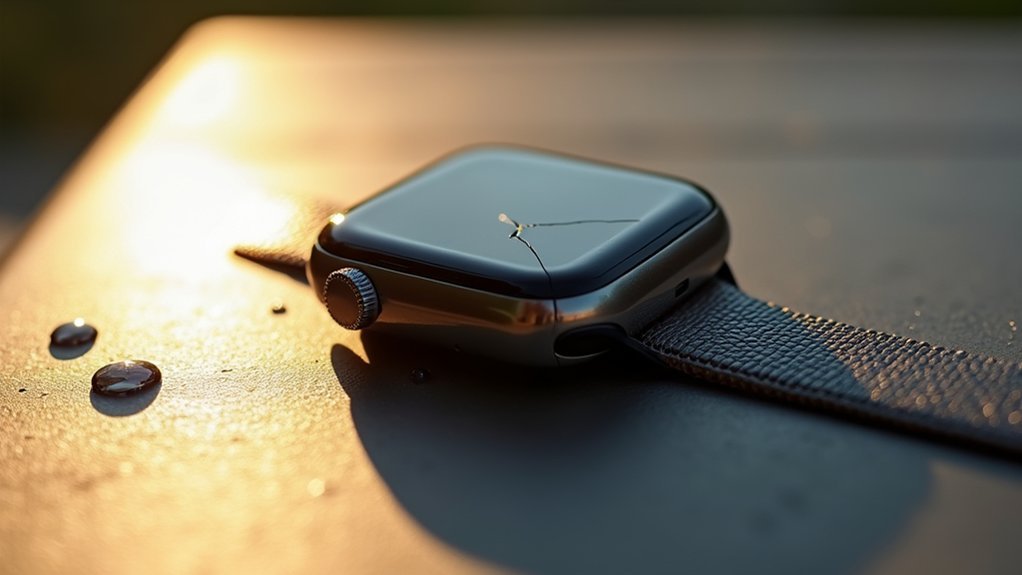



Leave a Reply